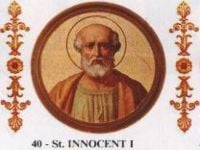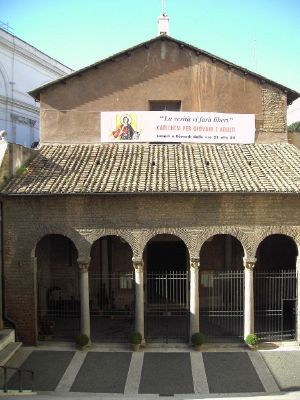Pope Innocent I
| Innocent I | |
|---|---|

| |
| Birth name | ??? |
| Papacy began | 402 |
| Papacy ended | March 12, 417 |
| Predecessor | Anastasius I |
| Successor | Zosimus |
| Born | ??? ??? |
| Died | March 12 417 ??? |
| Other popes named Innocent | |
Pope Saint Innocent I was pope from 401 to March 12, 417. The Liber Pontificalis gives his father's name as Innocens of Albano, but his contemporary, Saint Jerome indicates that his father was none other than his immediate predecessor, Pope Anastasius I (399-401).
A capable administrator and energetic proponent of Roman primacy, Innocent is remembered most for his role in condemning Pelagianism, his support of deposed patriarch of Constantinople John Chrysostom, and his unsuccessful attempt to negotiate an end to the siege of Rome by the Visigoth leader Alaric. Innocent also restored communications between the sees of Rome and Antioch, brining an end to the Meletian schism.
Although his feast day was previsouly celebrated July 28, in the Roman calendar it is now marked on March 12.[1] His successor was Zosimus.
Biography
Innocent's date of birth unknown. Saint Jerome indicates he was the son of the previous pope, Anastasius I, being born before the latter's ascension to the throne of Peter. A later biography in the Liber Pontificalis states that he was a native of the city of Albano and that his father was called Innocentius, the name Innocent would take as pope. He grew up among the Roman clergy and in the service of the Roman Church, probably holding the office of deacon before his elevation to the papacy. After the death of Anastasius (December 401) he was unanimously elected as bishop of Rome.
Activities in Rome
The church historian Socrates, himself a Novatianist, dubbed him "the first persecutor of the Novatians at Rome," and complains that he seized many Novatianist churches in Rome (Hist. Eccl., VII, ii). Innocent also succeeded in banishing from Rome a teacher called Marcus, an adherent of the heresy of Photinus. During his reign the Emperor Honorius issued a drastic decree from Rome (February 22, 407) against the Manicheans, the Montanists, and others (Codex Theodosianus, XVI, 5, 40), although it is not known if Innocent approved of it.
Through the generosity of a wealthy matron, Innocent gained the resources to build and richly support a church dedicated to Saints Gervasius and Protasius. This church still stands in Rome under the name of San Vitale, not to be confused with the more famous church of the same name in Ravenna.
The siege and capture of Rome (408-410) by the Visigoths under Alaric occurred during Innocent's pontificate, and the pope was actively, though unsuccessfully involved in the negotiations to lift the siege. In the first stage of the siege, a truce was arranged so that an embassy of Romans could go to Honorius at Ravenna to influence him to make concessions to Alaric, who had agreed to end the siege if his terms were met. Innocent joined this delegation, but his endeavors to bring about peace failed. When the Goths recommenced the siege, the pope and the other envoys were not able to return to the city. A report has been preserved indicating that the situation was so desperate that Innocent permitted prayers to be offered to pagan deities to end the siege, although few take this as fact. Rome was taken and sacked in 410.
Advocate of Roman primacy
From the beginning of his pontificate, Innocent often acted on the presumption that, as the bishop of Rome, he served as the head of the entire Christian Church, both East and West. In his letter to informing Archbishop Anysius of Thessalonica of his election to the See of Rome, Innocent reminded Ansysius that the privileges of his office had been bestowed on it by previous popes. Specifically, Pope Damasus I had asserted and preserved the rights of the papacy in those parts, and his successor Siricius had bestowed on the archbishop of Thessalonica the privilege of confirming and consecrating the bishops of Eastern Illyria. These prerogatives were renewed by Innocent at the beginning of his reign (Ep. i). A later letter (Ep. xiii, 17 June, 412) entrusted the supreme administration of the dioceses of Eastern Illyria to Archbishop Rufus of Thessalonica, as representative of the Holy See. The archbishops of Thessalonica thus became vicars of the popes.
Innocent likewise established effective papal administrative control in France and Spain. Bishop Victricius of Rouen (Ep. ii) had appealed to the pope to clarify a number of disciplinary matters. The points at issue concerned the consecration of bishops, appointment the clergy, and resolving disputes among clerics. On February 15 404, Innocent decreed that important matters were sent from the local episcopal tribunal to the Apostolic See at Rome, including the ordinations of the clergy, question of celibacy, the reception of converted Novatianists or Donatists into the church, etc. As a general principle, Innocent held that the discipline of the Roman Church should be the norm for other bishops to follow. Innocent directed a similar order to the Spanish bishops (Ep. iii). Similar letters were sent to Bishop Exuperius of Toulouse (Ep. vi), the bishops of Macedonia (Ep. xvii), Bishop Decentius of Gubbio (Ep. xxv), and Bishop Felix of Nocera (Ep. xxxviii). Innocent also addressed short letters to several other bishops, among them a letter to two British bishops in which he decided that those priests who had begotten children should be dismissed from their sacred office (Ep. xxxix).
Never willing to tolerate what he and the Roman Church considered as heresy, Innocent moved strongly against Montanism in Africa. A delegation of the synod of Carthage (404) to the Bishop of Rome appealed to him from severer treatment of the Montanists in that territory. After the envoys came to Rome, Pope Innocent obtained from the Emperor Honorius a strong decree against the Montanists of Africa, inducing some of them, out of fear of the state, to be reconciled with the Catholic Church.
Defense of John Chrysostom
The pope's energy also found a channel of expression in the Christian East, over the matter of Saint John Chrysostom. As bishop of Constantinople, Chrysostom had been deposed during the so-called Synod of the Oak presided over by the Alexandrian patriarch Theophilus allegedly at the behest of the eastern Empress Eudoxia, who had been offended by Chrysostom's preaching. Chrysostom appealed to Innocent for support. Theophilus, meanwhile, had already informed the Innocent of Chrysostom's supposedly lawful deposition. However, the pope did not recognize the sentence of the synod. He now dared to summon Theophilus, the patriarch of Alexandria, to new synod at Rome. Innocent also sent letters of consolation the exiled Chrysostom, as well as a letter to the clergy and people of Constantinople in which he scolded them severely for their conduct towards their bishop (Chrysostom). He also announced his intention of calling an ecumenical council, at which the matter would be sifted and decided. Realizing that Rome would be an unaccepted location for those of the East, he suggested Thessalonica as the place of assembly. The pope informed Honorius, emperor of the West, of these proceedings, and Honorius wrote three letters to his brother, the the eastern emperor Arcadius, asking him to summon the eastern bishops to meet at Thessalonica, before which Patriarch Theophilus must appear. This strategy met with complete failure, however, as Arcadius was quite favorable to Theophilus, and in any case was not about to allow Rome to act so heavy-handedly in church affairs. The synod never took place. The pope refused to recognize John's successor Arsacius and Atticus, on the grounds that John was still Constantinople's lawful bishop. Innocent also remained in correspondence with the exiled John until his death in 407 (Epp. xi, xii). After John's death, Innocent insisted that his name be restored to the diptychs (honor roles) in Constantinople's church. This was finally accomplished, but only after Theophilus was dead (412).
The Meletian schism between Rome and Antioch, dating from the Arian controversy, was finally settled in Innocent's time. This was accomplished when, after careful negotiations, Innocent recognized Patriarch Alexander of Antioch in 414, after the latter had succeeded in winning over to his cause the adherents of both the former Bishop Eustathius and the exiled Bishop Paulinus. Alexander agreed to restore the name of John Chrysostom to the Antiochene diptychs, and the pope at last entered into communion with the patriarch of Antioch, writing him two letters, one in the name of a Roman synod of 20 Italian bishops, and another in his own name (Epp. xix and xx).
Condemnation of Pelagius
Innocent was also a key player in the Pelagian controversy. In 415, the Synod of Jerusalem brought the matter of the orthodoxy of the British monk Pelagius—who affirmed an optimistic view of salvation at odds with Saint Augustine's emphasis on Original Sin—before the Holy See. A synod of Eastern bishops held at Diospolis (December 415) supported Pelagius and wrote to Innocent on his behalf. Hearing of this, a synod of African bishops assembled at Carthage in 416 and condemned him. The bishops of Numidia did likewise in the same year in a council at Mileve. Both of these African synods reported their acts to the pope and asked him to confirm their decisions. Soon after this, five African bishops, among them Saint Augustine, wrote a to Innocent regarding their own position in the matter of Pelagianism. In his reply Innocent praised the African bishops for being mindful of the authority of the See of Rome. He rejected the teachings of Pelagius and confirmed the decisions of the African synods (Epp. xxvii-xxxiii). The decisions of the Synod of Diospolis thus rejected by the pope.
Pelagius himself, stung by this condemnation in abstentia, now sent his personal confession of faith to Innocent. However Innocent died before the document reached Rome.
Legacy
Innocent was buried in a basilica above the catacomb of Pontianus and was venerated as a saint. The energy and competence which he brought to his office promoted the role of Rome as an administrative center and bolstered its claim to be the ultimate the arbiter of orthodoxy as the representative of Saint Peter. On the other hand, Innocent's aggressive interventions left some parties in the east feeling that Rome was more concerned about promoting its own authority that acting as a healing an unifying influence. Innocent thus typifies both great potential of the papacy as a force for orthodoxy and order, and also its tendency to judge harshly the actions of sincere Christians who happened to find themselves involved on the "wrong" side of a controversy.
The church which he dedicated in Rome still stands, known today as the church of San Vitale in Rome. In the West, his feast day is celebrated on March 12.
ReferencesISBN links support NWE through referral fees
- ↑ Calendarium Romanum (Libreria Editrice Vaticana, 1969), p. 132; Martyrologium Romanum (Libreria Editrice Vaticana, 2001 ISBN 88-209-7210-7)
External links
| Roman Catholic Popes | ||
|---|---|---|
| Preceded by: Anastasius I |
Bishop of Rome 401–417 |
Succeeded by: Zosimus |
| ||||||||||||||||
Credits
New World Encyclopedia writers and editors rewrote and completed the Wikipedia article in accordance with New World Encyclopedia standards. This article abides by terms of the Creative Commons CC-by-sa 3.0 License (CC-by-sa), which may be used and disseminated with proper attribution. Credit is due under the terms of this license that can reference both the New World Encyclopedia contributors and the selfless volunteer contributors of the Wikimedia Foundation. To cite this article click here for a list of acceptable citing formats.The history of earlier contributions by wikipedians is accessible to researchers here:
The history of this article since it was imported to New World Encyclopedia:
Note: Some restrictions may apply to use of individual images which are separately licensed.
